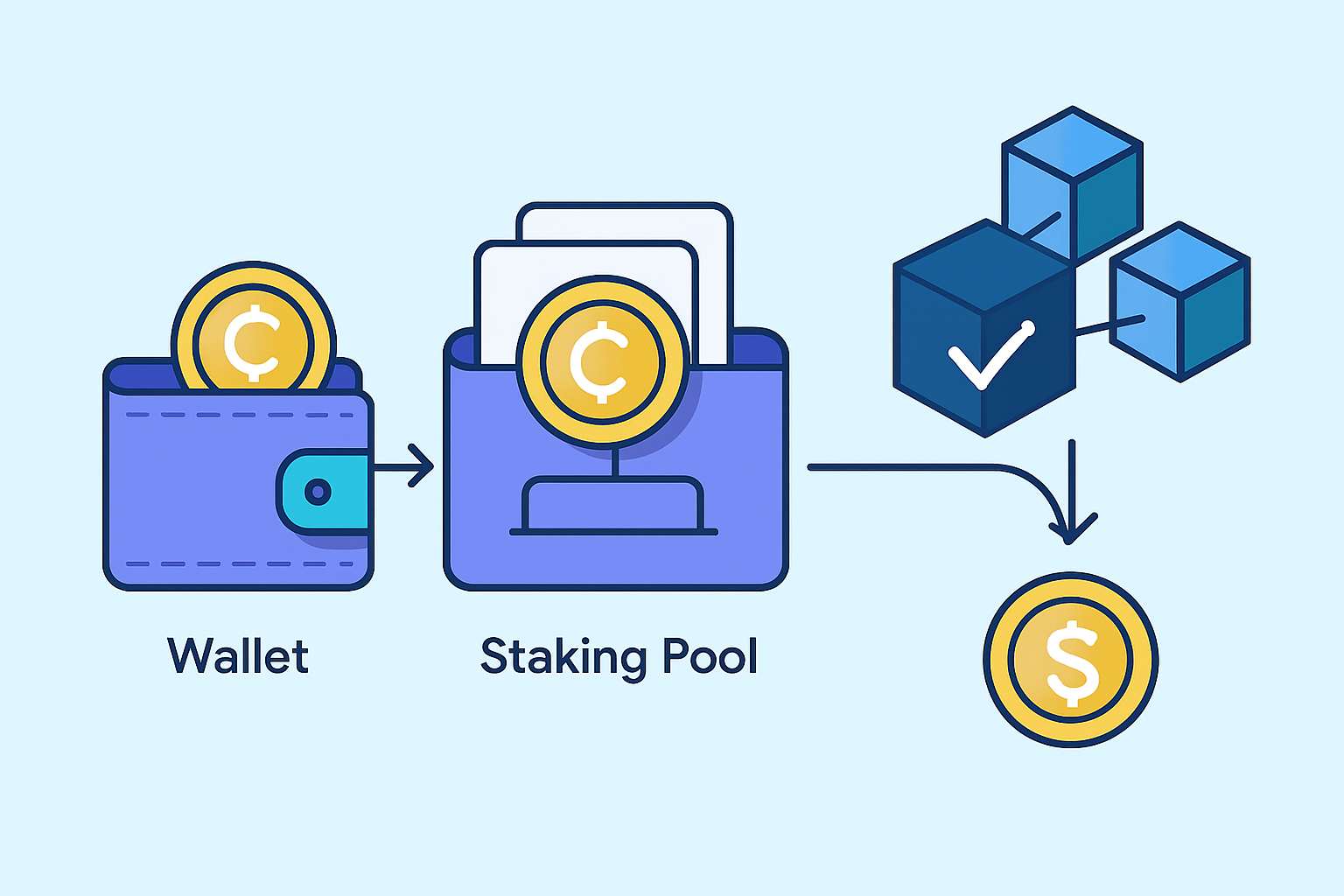How Crypto Staking Works to Earn Passive Income


This guide walks you through everything you need to know about earning rewards through crypto staking—no fluff, just the essentials.
- Dive into how crypto staking can be a nifty way to earn passive income by backing blockchain networks—no need to fuss over active trading or mining.
- Get the lowdown on staking choices, from direct staking to easier exchange-based options.
- Discover the perks of staking like being kinder to the planet by saving energy and helping keep decentralized networks safe.
- Keep an eye on potential bumps like unpredictable market swings, lock-up periods, and penalties such as validator slashing.
- Follow straightforward steps to start staking—like picking the right cryptocurrency and finding a reliable platform you can trust.
Passive income is basically the kind of earnings that don’t need much ongoing hustle and lets individuals gradually fatten their wallets without babysitting the process day in and day out. You’re probably familiar with classics like rental income or dividends from stocks. Lately cryptocurrencies have shaken things up by offering fresh ways to rake in passive income. Crypto staking has stolen the spotlight as a fan favorite. Instead of constantly buying or selling or mining, staking gives holders the perks of earning rewards simply by helping secure a blockchain network.
What Exactly Does Crypto Staking Mean?
Crypto staking is all about holding onto and locking up certain cryptocurrencies in a digital wallet to lend a hand in keeping a blockchain network humming smoothly. Participants step up to validate transactions and help secure the network, kind of like trustworthy gatekeepers.
- Blockchain: A decentralized digital ledger that keeps a reliable record of transactions spread across many computers. No single boss is in charge.
- Proof of Stake (PoS): A clever way to reach consensus where validators get picked based on how many coins they have locked.
- Validator: These individuals play a key role by confirming transactions and creating new blocks. They’re like the trusty referees of the system.
- Staking Rewards: The thank-you notes from the network, usually paid as extra cryptocurrency for staking your coins and helping keep things secure.
- Lock-up Period: The set amount of time your staked coins are tied up and cannot be moved.
- Crypto Wallets: Digital sidekicks that hold your cryptocurrencies and provide a safe place to stake them.
What Really Goes Down When You Stake Crypto
Staking basically means grabbing some cryptocurrency that runs on a PoS consensus and moving those coins into a staking wallet or platform where you lock them away for a certain stretch of time. The blockchain puts these staked coins to work by confirming transactions and sends rewards your way based on both the size of your stake and how long you’re willing to keep it locked down.
Choose a cryptocurrency that runs on Proof of Stake or something similar—think of it as picking the right team to play on.
Transfer your coins to a wallet or platform that actually lets you stake them—because not all wallets are created equal.
Lock up or delegate your coins to get in on the staking action, whether you fly solo or join a pool with others.
Your stake plays a key role in helping the blockchain verify new transactions and keep everything shipshape and secure.
Sit back and watch as you earn staking rewards on the regular, which will vary depending on your stake size and the network's little quirks.
Why Proof of Stake Matters and How It Works in Staking
Proof of Stake (PoS) is a consensus method that picks validators based on how many coins they put on the line rather than relying on brute computational muscle like Proof of Work (PoW) does. Staking is a feature unique to PoS and its various offshoots, letting holders earn rewards simply by pitching in to keep the network safe
Think of Proof of Stake as 'staking your claim'—you’re basically putting your trust (and those shiny coins) into a reliable validator, kind of like leaning on a friend who’s got your back to keep the network safe and sound.
Different Ways to Stake Your Claim
- Direct Staking: You take matters into your own hands by locking up your coins yourself, using a wallet or node that plays nice with staking.
- Delegated Staking: You pass the baton to a trustworthy validator who does the staking heavy lifting for you.
- Staking Pools: Think of this as a group effort—users pool their coins together, boosting their staking firepower and sharing the spoils.
- Liquid Staking: This nifty option lets you stake without putting your coins on ice, keeping them handy for trading or whatever else you fancy.
- Exchange Staking: The easy button—staking through a crypto exchange’s built-in service means less hassle and more convenience, perfect if you like things smooth and simple.
Direct staking tends to be the go-to for those who don’t mind rolling up their sleeves and diving into the technical details and gives them full control over their assets. Delegated staking usually wins over users who prefer to keep things simple by entrusting the heavy lifting to someone else. Staking pools are a great way for smaller investors to band together and lower the entry bar, though rewards are split among the group. Liquid staking offers flexibility by allowing individuals to trade or use their staked coins in DeFi while still earning rewards like having your cake and eating it too.
| Method | Description | Accessibility | Risk Level | Typical Rewards | User Requirements |
|---|---|---|---|---|---|
| Direct Staking | Take the reins and stake your coins yourself using a wallet or node. | Moderate (tech skills) | Lower (self control) | Medium to high | You’ll need some technical know-how and the right hardware |
| Delegated Staking | Hand over your stake to validators who handle the heavy lifting for you. | High | Moderate (trust) | Medium | Just a basic grasp of staking and a bit of trust in a validator goes a long way |
| Staking Pools | Pool your coins with others and stake as a collective—strength in numbers. | High | Moderate | Medium | Minimal fuss, just hop on a pooling service and you’re set |
| Liquid Staking | Stake your tokens but keep them liquid so you can still trade or use them on the fly. | Moderate | Moderate | Slightly lower | You’ll be working with liquid staking protocols, so a bit of familiarity helps |
| Exchange Staking | Sit back and stake through an exchange, with barely any effort on your part. | Very high | Moderate to high (custody) | Lower to medium | All you need is an exchange account, though watch out for the fees |

Why Crypto Staking Can Actually Work in Your Favor
Crypto staking is a neat way to earn passive income while helping keep the blockchain secure and decentralized. Unlike traditional mining that guzzles energy, staking sips power gently and is a breath of fresh air for the environment.
- Earn rewards consistently without needing to dive into trading or the hassle of mining yourself.
- Play a vital role in supporting the decentralization and security of blockchain networks simply by being a staker.
- Enjoy a much lighter footprint—using far less energy compared to the old-school, power-hungry cryptocurrency mining rigs.
- Benefit from potential upsides as your staked assets might just increase in value, on top of the steady rewards coming your way.
- Take advantage of liquid staking to keep your crypto handy and ready to move, all while it quietly works to earn you some income.
Risks and Things to Keep in Mind with Crypto Staking—A Little Heads-Up
Staking definitely has its perks but it’s not all sunshine and rainbows. There are some risks every investor should keep in mind. Token prices can swing wildly and sometimes wipe out any rewards you have carefully racked up. Many staking options require you to lock up your coins for a while which can limit your flexibility or delay access to your funds when you need them quickly. And don’t forget, validators aren’t off the hook either. Mistakes can lead to penalties like slashing where part of your stake simply disappears. Trust is another tricky issue especially when you’re staking through third parties or exchanges because you’re basically putting your faith in someone else’s hands.
- Sudden drops in market prices can unexpectedly chip away at the real value of your staking rewards, sometimes catching you off guard.
- Lock-up periods might tie up your funds just when you want to make a move, making it tricky to respond swiftly to those nagging market swings.
- Validators face slashing penalties if they go offline or misbehave, which unfortunately trickles down to everyone who’s delegated to them—no one likes a bad apple.
- Relying on third-party platforms comes with its own set of headaches, especially if those platforms get hacked or slip up in managing your funds.
- Inflation from new token issuances tends to sneakily eat away at the buying power of your staking rewards over time, so what seemed like a good deal today might lose some luster down the road.
Getting Started with Crypto Staking A Friendly Guide to Dip Your Toes In
If you are just diving into staking, check which cryptocurrencies are supported and pick staking methods that feel right for your comfort with risk and technology. Go for wallets or exchanges with a solid reputation that make staking straightforward. Make sure you’re clear on the minimum amounts required, any lock-up periods ahead and all the fees you might encounter.
Pick a PoS-based cryptocurrency that’s supported by staking platforms you can trust.
Set yourself up with a digital wallet or create an account on a reputable exchange that supports staking.
Double-check the minimum staking amounts and any lock-up periods before you jump in because these details can sneak up on you if you’re not careful.
Safely transfer your coins to your staking wallet or delegate them to a validator.
Keep a keen eye on your staking rewards and network news. Don’t hesitate to tweak your strategy if things start to shift. Staying flexible is half the battle won.
Common Myths About Crypto Staking (Busted and Explained)
Many newcomers often fall into the trap of thinking staking is risk-free or only for tech wizards. Some even imagine their staked coins are locked away forever or that rewards flow in like clockwork without a hitch. These little misconceptions can quickly turn into frustration or worse losses.
- Staking does not always guarantee profit since rewards can fluctuate depending on many factors.
- It is usually straightforward with many platforms offering user-friendly staking options beginners can handle.
- Typically your staked coins can be redeemed after a lock-up period so they’re not locked away forever, much to everyone’s relief.
- Rewards tend to shift with network conditions and are never set in stone.
- Staking doesn’t have to tie up your liquidity especially if you’re exploring clever techniques like liquid staking.
Looking Ahead at the Bright and Bumpy Road of Crypto Staking
Major networks like Ethereum wrap up their move to Proof of Stake with Ethereum 2.0, solidifying the foundation of crypto staking. This practice is steadily gaining traction and becoming more user-friendly. DeFi platforms are stepping up their game and rolling out sophisticated staking products. Institutional investors are beginning to dip their toes in as well.
Frequently Asked Questions
How much money do I need to start crypto staking?
The minimum amount depends on the cryptocurrency and the platform you pick. Some networks let you jump in with just a tiny bit while others expect you to bring a hefty sum if you want to run your own validator node. If your stash is on the smaller side, joining a staking pool usually makes sense because it pools your pennies with others to hit minimums together.
Is my crypto completely locked and inaccessible during the staking period?
In most traditional staking setups, your coins get locked up tight for a fixed period and you won’t be able to move or trade them until that’s over. That said, liquid staking is catching on fast and offers a neat workaround: you get a derivative token representing your staked assets. So you can still trade or put those tokens to work in DeFi while earning rewards. Pretty handy if you ask me.
What happens if the price of the cryptocurrency I am staking drops significantly?
If the price takes a nosedive it can shrink or, in the worst case, wipe out the value of your earned rewards. You’re still riding the rollercoaster of market risks here and the total fiat value of your stash—both staked coins and rewards—can drop. So it’s smart to keep this volatility in your back pocket before diving in.
What is 'slashing' and how can it affect my staked funds?
Slashing is a penalty that hits validators if they mess up badly, whether by acting maliciously or just being offline too much. This penalty slices off a chunk of their staked coins. If you’ve delegated your stake to a validator who gets slashed your portion might take a hit too. That’s why choosing a trustworthy and reliable validator is super important—nobody wants to lose funds because of someone else’s mistakes.
Is it better to stake directly or use an exchange like Coinbase?
Staking directly from your own wallet puts you in the driver’s seat with full control over your assets but it usually demands some technical savvy. On the flip side, using a well-known exchange is way simpler—especially if you’re just starting out—and takes care of the geeky stuff for you. Keep in mind though that you’re trusting a third party with your coins and there could be fees involved so there’s some custodial risk to consider.
Are staking rewards taxed as income?
In most parts of the world yes. Staking rewards generally count as taxable income based on their fair market value when you receive them. Later, selling those rewarded coins might also trigger capital gains taxes. It’s worth chatting with a tax pro to nail down how the rules apply to your situation because nobody wants unpleasant surprises come tax time.
Start Your Crypto Journey with Coinbase Today
Ready to enter the cryptocurrency market but unsure where to begin? Coinbase makes buying, selling, and storing digital assets simple and secure for beginners and experts alike.








